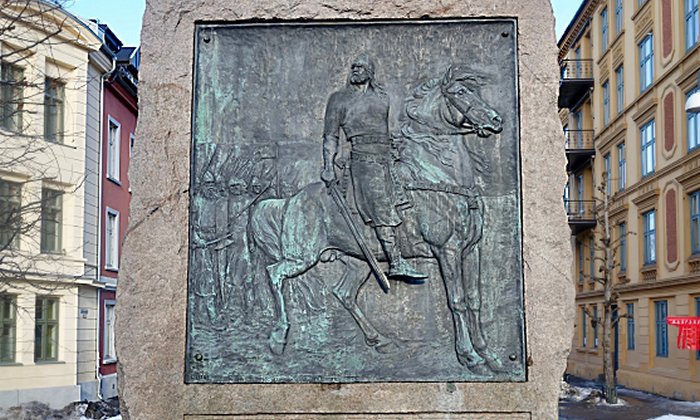Mighty Viking Harald Hardrada – The Last Great Viking And Most Feared Warrior Of His Time
Ellen Lloyd - AncientPages.com - We associate all these names – Ragnar Lodbrok, Ivar the Boneless, Bjorn Ironside, Erik the Red, Eric "Bloodaxe" Haraldsson - with courageous and fearsome Viking warriors.
However, none of them can be compared to the greatest Viking warrior of all - King Harald Hardrada.
Monument to Harald Sigurdsson at Harald Hardrådes plass in Gamlebyen, Oslo, Norway. Relief by Lars Utne 1905. Harald Sigurdsson (Old Norse: Haraldr Sigurðarson; c. 1015 – 25 September 1066), given the epithet Hardrada (Old Norse: harðráði, modern Norwegian: Hardråde, roughly translated as "stern counsel" or "hard ruler") in the sagas, was King of Norway (as Harald III) from 1046 to 1066. Image credit: Wolfmann - CC BY-SA 4.0
Mighty King Harald Hardrada was the last great Viking and the most feared warrior of his world and time.
Viking Hardrada was an extraordinary man who lived an adventurous life. His courage and combat skills made him a military commander in the Varangian Guard and Kievan Rus'.
He fought in the deadliest battles and traveled to distant lands where he met exotic and influential people.
Hardrada spent all his life as a professional soldier, and his reputation preceded him.
In the Icelandic Sagas, Viking Hardrada is portrayed as a great hero. Still, behind all the ancient legends, we find a very complex figure, a charismatic, daring, and resourceful man. Viking warrior Hardrada became a patron of poets, and he was known as the 'feeder of ravens.'
Harald Hardrada – A Great Viking Warrior Is Born
The most comprehensive accounts of King Harald Hardrada's life can be found in the thirteenth-century collections of sagas of the Norwegian kings, of which the most respected is the one known as Heimskringla and reliably attributed to the Icelandic historian, poet, and politician Snorri Sturluson (1179 - 1241).
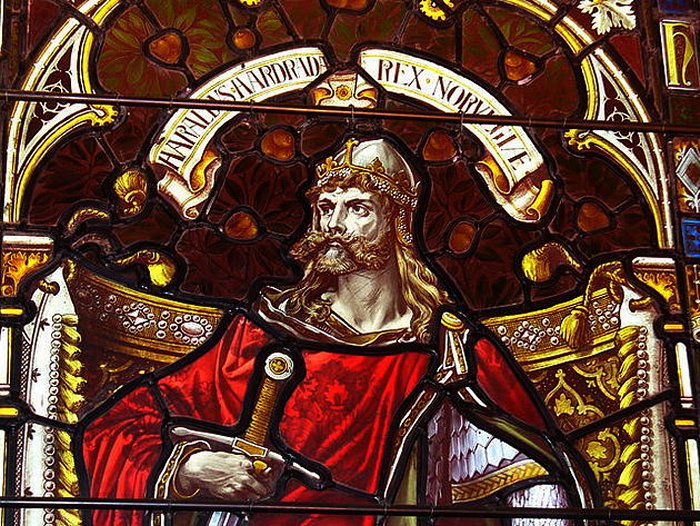
Window with a portrait of Harald Hardrada, Lerwick Town Hall, Shetland. Image credit: Colin Smith - CC BY-SA 2.0
German churchman Adam of Bremen also documented some of King Hardrada's expeditions, but the cleric's writings are hostile and far from objective. He does, however, confirm the great Viking's military skills and warlike reputation when he refers to Hardrada as the 'thunderbolt of the north.'
Born as Harald Sigurdsson in Ringerike, Norway, in 1015, he was the child of Åsta Gudbrandsdatter and her second husband Sigurd Syr, a king of Ringerike and one of the wealthiest chieftains of Upplands, the lands and forest regions to the north of Oslo in Norway. After his death, he was given the title "Hardrada," which means "hard ruler."
From her first marriage, Åsta Gudbrandsdatter was also the mother of King Olaf Haraldsson of Norway, who was later to become St. Olaf.
Hardrada admired his half-brother, King Olaf, very much, and it could not have been easy to see him die in a battle. This event was significant to Hardrada's personal destiny and changed his life. Hardrada was loyal to his half-brother until the end.
Harald Hardrada Fought In The Battle Of Stiklestad When He Was 15 Years
When Hardrada was 15 years old, he engaged in his first battle under the command of his half-brother and hero, King Olaf. Snorri Sturluson's Heimskringla describes what happened during the war of Stiklestad, and one can say this was the beginning of Viking Hardrada's military career.
In 1028, there was a revolt, and King Olaf lost the Norwegian throne to Cnut the Great, England's Danish king and ruler of one of the largest Nordic Empires.
The Battle of Stamford Bridge and the death of Harald Hardrada (wielding a battleax). Image source
King Olaf, who had been baptized, did his best to convert Norway to Christianity. He also revived and revised the law code of Harald Fairhair, the king who united Norway into one kingdom in 872 AD. He affirmed his influence in the North Atlantic colonies, most notably in the jarldom of Orkney, and he prohibited plundering, but only within the country.
There is no doubt that King Olaf made many crucial changes, but his days numbered. Cnut the Great had other plans. He wanted to reclaim Norway's throne, and King Olaf was forced into exile.
Two years later, in 1030, King Olaf returned to Norway with a force of more than fourteen hundred strong, and he was joined by Hardrada and his group of 700 hundred warriors. Together, they engaged the army of Cnut the Great, but the battle did not end well. King Olaf was killed, and Hardrada was severely wounded and forced to flee. Though he was only 15 years old, he showed excellent combat skills during the battle.
Snorri Sturluson described Harald Hardrada as physically "larger than other men and stronger." His appearance must have been striking to some. He is said to have had light hair and beard, an extended "upper beard" (mustache), and one of his eyebrows was somewhat higher situated than the other. He reportedly had big hands and feet and could measure five ells in height.
Viking Hardrada Joins Kievan Rus And The Varangian Guard
Hardrada managed to cross the Baltic with other survivors of Olaf's defeated army in one year. After arriving in Russia, he visited his distant relative Yaroslav I, Grand Prince of Rus, known as Yaroslav the Wise. The prince had helped King Olaf after the revolt. Needing skilled warriors, he employed Viking Hardrada, who became captain of the forces of Prince Yaroslav of Kievan Rus. Hardrada fought many battles for Grand Prince Yaroslav the Wise.
Credit: Adobe Stock - Nejron Photo
After spending some years in Prince Yaroslav's army, Hardrada left Kyiv with his warriors and traveled to Constantinople, the capital of the Byzantine Empire. '
His goal was to join the impressive Varangian Guard representing the elite heavy infantry regiment of the Roman ('Byzantine') Empire from AD 988 AD to around 1404 AD.
They were Vikings for hire who successfully conquered territories across the Empire. They fought in Crete, Italy, and Asia Minor.
These professional warriors were highly valued for their courage and loyalty; they also had high fighting skills and the ability to carry out commands efficiently and without unnecessary questions. Harald Hardrada joined the Varangian Guard. He was the best berserker who became the "leader over all the Varangians." Berserkers (in Old Norse: 'berserkr') were Icelandic Viking warriors who feared enemies and even their battle companions
As commander, he fought in places as far apart as the Mediterranean, Asia Minor, Sicily, and the Holy Land. He was a famous and respected military leader. Hardrada now had enough earnings to marry Yaroslav's daughter Princess Elisaveta (Elisiv), something he could not do earlier because he was too poor.
Rich in combat experience and wealth, Hardrada returned to Scandinavia in 1046. He had carefully prepared his campaign of reclaiming the Norwegian throne. Cnut the Great had died, and Magnus I, also known as Magnus the Good, was now king of Norway.
Harada reached an agreement to share the rule of Norway with Magnus I. When Magnus I died, Harada became the sole King of Norway.
Harada was not happy with only being the king of Norway. He also wanted to rule Denmark, and he and his warriors plundered the country repeatedly. Still, the Danish King Svein Estridsson, who lost almost every battle against Harald, managed to stay in power. In 1064, Harald and Sweyn reached a peace agreement.
Knowing Denmark could not be his, the warrior King Hardrada sought new grounds that he and his men could conquer. Hardrada was now keeping his eye on England.
Battle At Stamford Bridge And The Death Of King Hardrada
After the death of Edward the Confessor, the English throne passed to Harold Godwinson. King Hardrada allied himself with Tostig Godwinson, Harold's brother, who had been deprived of the earldom of Northumbria by Edward in 1065.
In 1066, Saxon troops of Mercia and Northumbria, commanded by brothers Earl Edwin and Earl Morcar, met a Norse army under King Harald Hardrada accompanied by Earl Tostig.
King Hardrada and William, Duke of Normandy, wanted the throne of England. William gathered a fleet and was ready to sail across the Channel to the south coast of England; Harald gathered an invasion force in the north. The Norman army had only 7,000 men. King Hardrada's Viking warriors met the troops from Mercia and Northumbria, at Fulford, on the outskirts of York, and the battle took place.
It was a terrible fight in which the armies of Mercia and Northumbria were defeated. York surrendered to the invaders, and Harald did not enter the city but retired to Stamford Bridge to await the gathering of hostages from around the region.
It was a huge mistake. The Norse warriors had only five days to enjoy their victory at Fulford.
On 25 September, King Harold, the last Anglo-Saxon king of England, surprised Harald Hardrada of Norway at Stamford Bridge and defeated the Norsemen. Hardrada and Tostig were killed. Harald Hardrada's death was caused by an arrow that struck his neck. He was buried at the Mary Church in Nidaros, Norway.
In a way, it's a bit ironic that a great warrior like Hardrada, who traveled to distant lands and fought in the deadliest battles, died after spending only a few days on British soil.
Mighty Warrior King Hardrada As A Person
With the death of King Hardrada, the Viking Age ended. Hardrada was a harsh ruler who often solved disputes with force, but his reign was one of peace and progress for Norway. He advanced Christianity in Norway and built churches and imported bishops. He developed a Norwegian currency and viable coin economics. His contacts with the Byzantine Empire and Kyiv helped Norway to expand its international trade. King Hardrada also founded the capital, Oslo.
Harald Hardrada was the last great Viking.
Updated on February 15, 2024
Written by - Ellen Lloyd – AncientPages.com
Copyright © AncientPages.com All rights reserved. This material may not be published, broadcast, rewritten or redistributed in whole or part without the express written permission of AncientPages.com
Expand for referencesMore From Ancient Pages
-
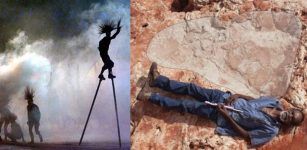 Aboriginal Creation Story Of Marala Was True – World’s Largest Dinosaur Footprints Confirm Ancient Creation Myth
Archaeology | Mar 29, 2017
Aboriginal Creation Story Of Marala Was True – World’s Largest Dinosaur Footprints Confirm Ancient Creation Myth
Archaeology | Mar 29, 2017 -
 Controversial Ancient History: Did Humans Evolve From Reptilians? The Serpent Connection From Ancient Myths To Modern Science
Ancient Mysteries | Jul 23, 2015
Controversial Ancient History: Did Humans Evolve From Reptilians? The Serpent Connection From Ancient Myths To Modern Science
Ancient Mysteries | Jul 23, 2015 -
 On This Day In History: Antonio Neri Was Born in Florence, Italy – On Feb 29, 1838
On This Day In History | Feb 29, 2020
On This Day In History: Antonio Neri Was Born in Florence, Italy – On Feb 29, 1838
On This Day In History | Feb 29, 2020 -
 How And When Did Ancient People Start Using Oil?
Ancient History Facts | Jun 28, 2018
How And When Did Ancient People Start Using Oil?
Ancient History Facts | Jun 28, 2018 -
 207-Year-Old Whaling Shipwreck Discovered In Gulf Of Mexico
Archaeology | Mar 23, 2022
207-Year-Old Whaling Shipwreck Discovered In Gulf Of Mexico
Archaeology | Mar 23, 2022 -
 4,000-Year-Old Stonehenge Of The Netherlands Reveals Its Secrets
Archaeology | Jun 22, 2023
4,000-Year-Old Stonehenge Of The Netherlands Reveals Its Secrets
Archaeology | Jun 22, 2023 -
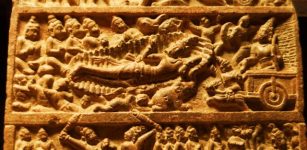 Decoding Ancient Secrets Of Fascinating Virupaksha Temple
Archaeology | Nov 15, 2014
Decoding Ancient Secrets Of Fascinating Virupaksha Temple
Archaeology | Nov 15, 2014 -
 Ancient Giant Skeleton Discovered In Krabi Cave Confirms Legend Of The Nagas – Or Perhaps Not
Archaeology | May 17, 2020
Ancient Giant Skeleton Discovered In Krabi Cave Confirms Legend Of The Nagas – Or Perhaps Not
Archaeology | May 17, 2020 -
 New Study Challenges Theories Of Earlier Human Arrival In Americas – Archaeological Evidence Has Been Misinterpreted – Scientists Say
Archaeology | Apr 21, 2022
New Study Challenges Theories Of Earlier Human Arrival In Americas – Archaeological Evidence Has Been Misinterpreted – Scientists Say
Archaeology | Apr 21, 2022 -
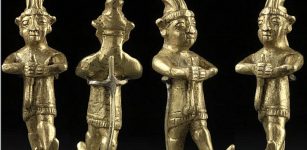 Golden Figurine From Yozgat Depicts Unknown Hittite God
Artifacts | May 11, 2016
Golden Figurine From Yozgat Depicts Unknown Hittite God
Artifacts | May 11, 2016 -
 Secrets Of Mysterious Bronze Age Hoard Found In Rosemarkie, Scotland Revealed
Archaeology | Jul 31, 2024
Secrets Of Mysterious Bronze Age Hoard Found In Rosemarkie, Scotland Revealed
Archaeology | Jul 31, 2024 -
 Is ‘Someone’ Regularly Altering The Course Of History? – Unexplained Events – Part 2
Ancient Mysteries | Dec 3, 2020
Is ‘Someone’ Regularly Altering The Course Of History? – Unexplained Events – Part 2
Ancient Mysteries | Dec 3, 2020 -
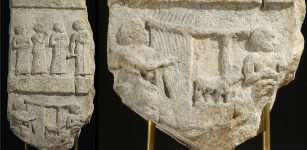 Mesopotamian Music Stele That Commemorates Gudea King Of Lagash In Temple Foundation Ceremony
Artifacts | Dec 12, 2016
Mesopotamian Music Stele That Commemorates Gudea King Of Lagash In Temple Foundation Ceremony
Artifacts | Dec 12, 2016 -
 Ancient DNA Reveals How Yamnaya People Re-Wrote Northern Europeans’ Genetic Story 5,000 Years Ago
DNA | Jan 12, 2024
Ancient DNA Reveals How Yamnaya People Re-Wrote Northern Europeans’ Genetic Story 5,000 Years Ago
DNA | Jan 12, 2024 -
 Fascinating Discovery – First Female Viking Grave Discovered In Swedish Mountains
Archaeology | Aug 20, 2022
Fascinating Discovery – First Female Viking Grave Discovered In Swedish Mountains
Archaeology | Aug 20, 2022 -
 Lost Ancient Mayan Cities Lagunita And Tamchen Hidden In The Jungle Reveal Their Secrets
Featured Stories | Jun 25, 2017
Lost Ancient Mayan Cities Lagunita And Tamchen Hidden In The Jungle Reveal Their Secrets
Featured Stories | Jun 25, 2017 -
 Pre-Clovis, Paisley Caves: Archaeologists Identified The Earliest Population Of North America
Archaeology | Jul 16, 2020
Pre-Clovis, Paisley Caves: Archaeologists Identified The Earliest Population Of North America
Archaeology | Jul 16, 2020 -
 Unique Bronze Age Treasure Discovered In Swedish Forest Was A Gift To Norse Gods
Archaeology | Apr 30, 2021
Unique Bronze Age Treasure Discovered In Swedish Forest Was A Gift To Norse Gods
Archaeology | Apr 30, 2021 -
 Very Rare Ancient Roman Horse Brooch Discovered In UK
Archaeology | Mar 7, 2020
Very Rare Ancient Roman Horse Brooch Discovered In UK
Archaeology | Mar 7, 2020 -
 Roman-Byzantine Grave Unearthed In Turkey
Archaeology | Jan 28, 2016
Roman-Byzantine Grave Unearthed In Turkey
Archaeology | Jan 28, 2016

